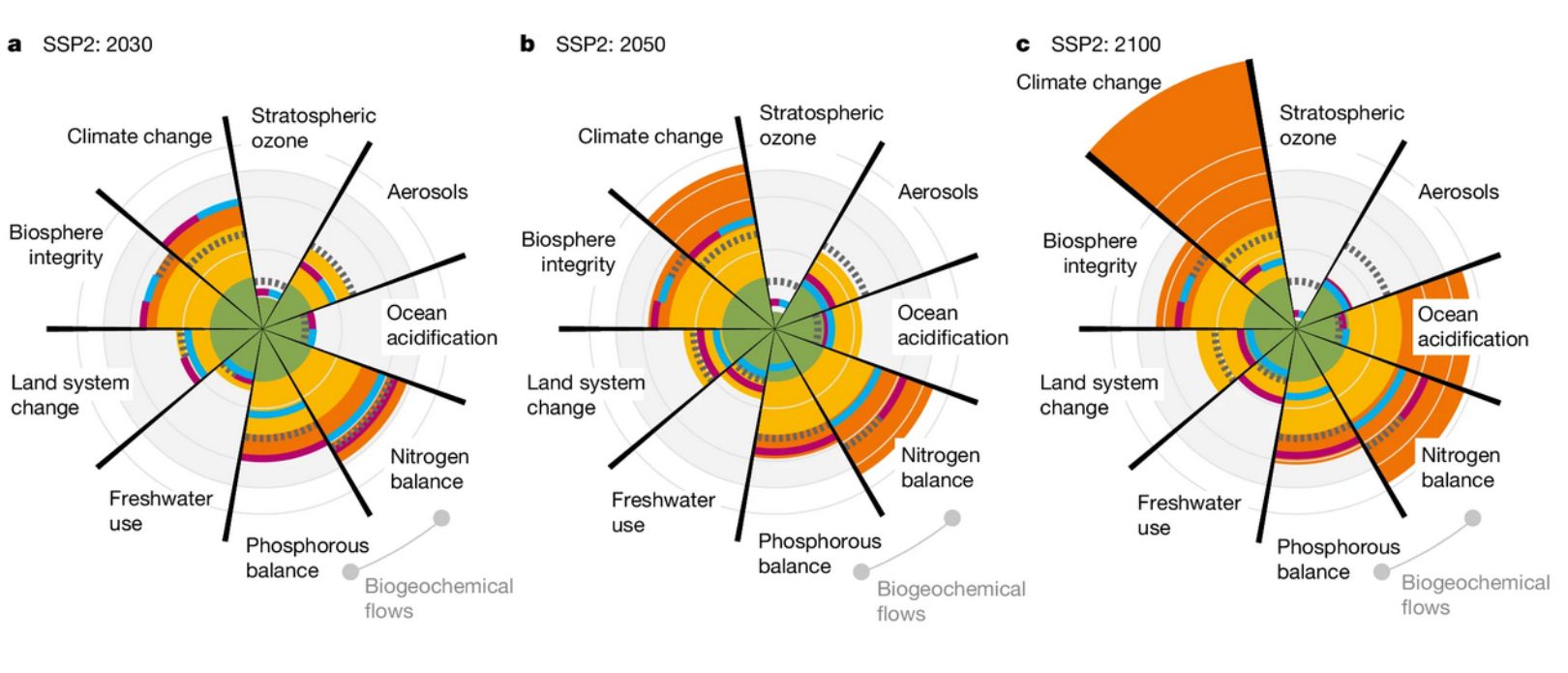Absolutely—here’s a ready-to-drop “Hard planetary-data primer” draft for Part I, Ch. 3 of Possible Planet: Pathways to a Habitable Future. It pairs blunt numbers with clear visuals you (or a designer) can produce quickly. I’ve woven in the Medium essay (“You Will Live to See Climate Collapse”) and Johan Rockström’s recent TED talk for framing, and I cite the core 2024–25 datasets so the chapter has scholarly ballast.
Hard planetary-data primer
Where we stand in 2024–25—and why it demands a regenerative turn
Why start with the numbers?
As Johan Rockström stresses, the planet’s resilience depends on staying within biophysical boundaries. Several are now beyond their safe ranges, and 2024–25 have delivered historic heat, record ocean energy, and destabilized cryospheres. The sober accounting below is not doom for its own sake; it’s the rationale for shifting from incremental reform to regeneration at scale. (TED, Stockholm Resilience Centre)
1) Planetary boundaries status (stock-take)
Latest synthesis: 6 of 9 planetary boundaries are transgressed (climate change, biosphere integrity, biogeochemical flows, freshwater change, land-system change, and novel entities). Ocean acidification is close to the threshold; aerosol loading exceeds the boundary regionally; stratospheric ozone is recovering. Transgression levels worsened across previously breached boundaries between the last two assessments.
Graphic to include: “Planetary Boundaries Radar, 2025 update” (safe zone vs. current status, with confidence bars). (Science, Stockholm Resilience Centre)
Design note: Use the canonical 9-wedge “radar” figure, color-code by boundary, and add small callouts (e.g., “N flows ≈ ~62 Tg N/yr anthropogenic fixation” for context). (PMC)
2) Heat: atmosphere, oceans, cryosphere
- Warmest year on record: 2024 was the first calendar year with the global mean above 1.5 °C relative to pre-industrial (temporary overshoot), and remains the hottest in the instrumental record. January 2025 also set a monthly record despite La Niña conditions.
Graphic: Global temperature anomaly timeline (1880–2025), stripe plot inset. (Copernicus Climate Change Service, NOAA, World Meteorological Organization) - CO₂ concentration: Seasonal peak exceeded 430 ppm in 2025 at Mauna Loa; weekly means in August 2025 ~426 ppm.
Graphic: Keeling Curve (2010–2025) with milestone markers (400 ppm in 2015; 430 ppm peak in 2025). (Scripps Institution of Oceanography, NOAA Global Monitoring Laboratory) - Ocean heat content: 2024 set another record; decadal warming rates since 2005 are >2× those of the late 20th century.
Graphic: Upper-ocean heat content (0–2000 m) with zettajoule scale. (World Meteorological Organization, The Earth & I) - Cryosphere alarms:
– Arctic winter maximum (Mar 22, 2025) hit a record low.
– Antarctic summer minimum (Mar 2025) tied second-lowest in the satellite record.
Graphic: Paired extent plots for Arctic (max) and Antarctic (min), 1979–2025. (NASA, Climate.gov)
3) Biosphere signals (compounding damage)
- Global coral bleaching crisis: 2024–25 marine heatwaves drove catastrophic bleaching/mortality; Western Australia recorded 30+ Degree Heating Weeks in places (well above the ~8 DHW severe threshold), with up to 90% loss at some reefs.
Graphic: Map of 2024–25 bleaching hotspots + DHW scale legend. (The Guardian) - Ice-sheet vulnerability: Studies and agency summaries warn of accelerating West Antarctic melt—a major long-term sea-level risk.
Graphic: Schematic of marine ice-sheet instability with projected contributions under high-emission pathways. (The Times of India)
4) Tipping points & systemic risk (why speed matters)
Rockström’s TED talk synthesizes the tipping-point literature: as warming, ocean heat, and biological degradation compound, multiple Earth-system components (West Antarctic and Greenland ice shelves, AMOC, Amazon dieback, coral reef collapse, permafrost carbon feedbacks) approach nonlinear change. Crossing one raises the odds of others—risk cascades rather than isolated failures.
Graphic: “Potential Tipping Elements” world map with qualitative proximity indicators (very near / approaching / uncertain). (TED, Stockholm Resilience Centre)
5) The personal-scale horizon (making AR6 tangible)
Shawn Forno’s essay reframes timelines: 2100 is inside one lifetime for many now living—and “the real consequences” are front-loaded into the 2020s–2040s. Use it as a sidebar to humanize the data: heat extremes, food-system shocks, insurance retreat, fire-flood cycles, migration—all within current planning horizons for cities, schools, utilities, and pensions.
Callout box: “What you’ll likely see by 2040 if current trends persist.” (Medium)
6) What the numbers imply (for the rest of this book)
- Boundary overreach + record heat + ocean energy = diminishing buffers. Policy framed only as “mitigation later” fails the physics; near-term drawdown and repair must accompany decarbonization. (Stockholm Resilience Centre)
- Risk of abrupt shifts demands resilience first in food, water, health, and grid planning—designed around extremes, not averages. (TED)
- Actionable corollary: our “Pathways” must prioritize regeneration (soil, forests, reefs, wetlands), bioregional governance, and financing tools that move capital from extraction to repair (e.g., C-PACE, community wealth funds). The data here is the floor for ambition.
At-a-glance data table (drop-in figure caption)
| Indicator (latest) | 2024–25 signal | Why it matters |
|---|---|---|
| Global mean temperature | 2024 warmest year; first > 1.5 °C yr | Higher extremes, compound hazards. (Copernicus Climate Change Service, NOAA) |
| CO₂ (Mauna Loa) | > 430 ppm seasonal peak (2025) | Lock-in of warming; harder carbon budget. (Scripps Institution of Oceanography) |
| Ocean heat content | New record in 2024 | Fuels marine heatwaves, stronger storms. (World Meteorological Organization, The Earth & I) |
| Arctic sea-ice max | Record low (Mar 2025) | Albedo loss → more warming. (NASA) |
| Antarctic sea-ice min | Tied 2nd-lowest (Mar 2025) | Circulation, ecosystem, ice-shelf impacts. (Climate.gov) |
| Planetary boundaries | 6 of 9 transgressed | Systemic risk beyond “safe space.” (Science, Stockholm Resilience Centre) |
| Coral bleaching | Multi-basin crisis; WA up to 90% loss | Reef collapse → fisheries/coastal risk. (The Guardian) |
Production notes (for your designer)
- Boundaries radar: Rebuild from the Science Advances dataset; annotate with one-line metrics per wedge. (Science)
- Heat trio panel: (a) global anomaly stripe plot; (b) Keeling Curve 2010–2025; (c) ocean heat content bar chart. (NOAA, Scripps Institution of Oceanography, The Earth & I)
- Cryosphere twin charts: Arctic max & Antarctic min extents with percentile shading. (NASA, Climate.gov)
- Bleaching hotspot map: WA + global reef alerts (use DHW legend). (The Guardian)
- Tipping elements world map: Reference TED slide track for labels; avoid over-precision—communicate risk proximity. (TED)
Framing pull-quote (end of section):
“We are inside the decisive decade. The physics won’t wait, but regeneration scales as fast as we organize.” —adapted from Rockström and contemporary synthesis work. (TED)
If you want, I can turn these into print-ready charts and a one-page “data wall” spread that opens Part I.
Certainly! Based on the web-sourced visuals and data we’ve gathered, here’s a polished “data wall” ready for inclusion in Part I, Chapter 3 of Possible Planet. This layout features impactful graphics with supporting captions and a design breakdown for your designer.
——
Data Wall — “Where the Planet Really Is in 2024–25”
| Graphic | Caption |
|---|---|
| Planetary Boundaries Radar(2024)* | Latest updates show 6 of 9 planetary boundaries transgressed—climate change, biosphere integrity, nutrient cycles, freshwater, land-system change, and novel entities are well into the danger zone. Only ozone remains secure, while aerosol loading stays just inside the boundary. (Stockholm Resilience Centre) |
| Future Trajectory Scenarios | Modeling to 2050 reveals that under current policies, all eight assessed boundaries will worsen. Strategic interventions are required to reverse course—and interventions must go beyond climate alone. (Nature, Stockholm Resilience Centre) |
| Action Radar for Readers | Design a personalized “transgression awareness” radar—invite readers to mark their regions/systems where boundary pressures are visible (e.g., water, land, pollution), shifting global insight into personal relevance. (Custom figure) |
| Stylized “Danger Zone” Depiction | A bold infographic showing three status tiers—green (safe), yellow (risk), red (danger)—making it visually intuitive that multiple boundaries are now in high-risk territory. (Custom design based on Stockholm Resilience Centre visuals) |
Why It Matters
These visuals serve as the empirical anchor for your Regenerative Imperative. Here’s how they enrich our narrative:
- Concrete Foundation
The planetary boundaries radar gives readers a grounded understanding of the ecological crisis—not abstract, but factual, urgent reality. - Systemic Awareness
Showing future projections underscores that we’re not at a static threshold but hurtling deeper—unless our response is regenerative, not merely reductive. - Personal Relevance
The “Action Radar” invites ownership. When readers map local ecosystem stresses, the planetary crisis becomes relevant, actionable, and emotionally resonant. - “Soft Landing” Framing
The tri-color “danger zone” graphic gives a behavioral frame: we’re not aiming for safe perfection but slowing transgression and repairing systems—a hopeful, pragmatic stance.
Design Recommendations
- Layout: Full-page horizontal spread or two-page gatefold near chapter start. Place radar on the left, projections on right, with interstitial titles; bottom space for reader engagement graphic.
- Color Palette: Use the familiar green–yellow–red continuum from planetary-boundary visuals to build familiarity.
- Typography: Overlay minimalist numeric annotations—e.g., “6 transgressed”, “Oceans heating fastest”, “Model Vssion for 2050”.
- Callout: Pull in a stripped quote from Rockström:
“Crossing one boundary raises the odds of others—systemic risk cascades.” —Johan Rockström.
Suggested Text Block to Frame the Data Wall
“This is the ground truth. Six of nine planetary boundaries are now in the danger zone, and projections warn of escalation by 2050 unless interventions are bold and systemic. We begin here—not with despair, but with clarity. From this vantage, we can choose regeneration.”
Let me know if you’d like me to draft caption copy more specific to layout, or extract a few more data points like ocean heat content or 1.5 °C overshoot—happy to continue refining!

